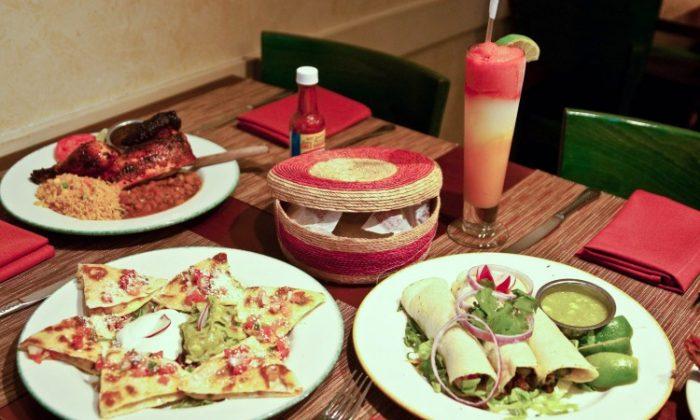NEW YORK—Most Mexican food is simple to make, yet that simplicity gives rise to many colorful dishes, lively flavors, and vibrant sauces. Many recipes share common ingredients—such as cilantro, lime, tomatoes, onions—and with dishes meant to highlight the flavor of each one, it’s only fitting that one of the open secrets to good Mexican food is sourcing fresh ingredients.
This secret was one of the underlying themes of a Feb. 13 event hosted by Edible Manhattan at the Brooklyn Brewery, where some of the city’s more popular Mexican food artisans delved into the arts of making good tortillas, fresh salsa, and delectable Mexican desserts.
A Good Tortilla Stands on Its Own
Tortillas are often the neglected piece of a good taco—treated more as a food-to-mouth delivery system than an essential part of the meal. But if you ever taste an authentic, homemade tortilla, you'll quickly realize that a tortilla is so much more.
“I think a lot of times people don’t even notice the tortilla—it’s the last thing you think about. But the corn tortilla should taste like corn,” said Tracie Lee, who co-owns Lonestar Taco alongside her husband, Wayne Surber.
Lee and Surber demonstrated their tortilla-making skills at the event. A few jars of corn were lined up on their table, next to a press to form the corn tortillas and a stone slab to roll out the flour ones.
The couple’s foray into the world of Mexican food began with a dilemma—Surber hails from San Antonio, Texas, a land where breakfast tacos can be found in the hands of its many breakfast-goers. Yet the compact breakfasts-in-a-pocket were nowhere to be found in New York City.
“I didn’t know about breakfast tacos before I met him, then we went down to Texas, and I was like, what is this? Why are these everywhere? And why aren’t they in New York?” said Lee.
When they decided to set up shop and share their love for tacos with New York City, they both agreed that the foundation of any good taco is a good tortilla—quite literally.
Lee said, “Often, you'll see people doubling up their tortillas,” indicating “you’re using a tortilla that isn’t homemade.” The two cooked up a few tortillas for their demonstration, and these corn tortillas were thick and soft, and noticeably more durable than the flaky, flimsy corn tortillas found in supermarkets.
“That’s what’s good about making them from scratch—you get them a bit thicker, and when you put the meat and everything in it, it stands up to the sauce,” Lee said.
Tortillas aren’t made from your typical flour-water combo, either. They usually have a nice heap of lard thrown in. In order to appease vegetarians and the occasional person uninterested in eating lard, Lee and Surber often substitute the lard with butter and milk, or—for vegans—vegetable oil.
The corn tortillas, meanwhile, are made from masa—dried corn that has been through a process called nixtamalization, which usually entails soaking dried corn in lime and water. After that, it’s ground up into a fine powder, and then mixed with water to create a dough. The process makes the corn digestible and also brings out its nutrients.
Surber also noted the process is necessary for the overall tortilla-making process. “Corn doesn’t have gluten, and that’s why the nixtamalization process is important—it lets the corn act like flour,” he said, during his demonstration.
‘Everything Is Salsa’
The guiding philosophy of the Brooklyn Salsa Company is that salsa is sauce, and so it is blended smooth rather than chunky. Yet, the people behind it also understand that while salsa has a simple base, the possibilities of slight alteration and style are nearly limitless.
“Salsa is like food art,” said Matt Burns, co-founder and creative taste operator of Brooklyn Salsa Company, as he addressed the crowd about how to make salsa.
The process is very simple. It only took Burns around five minutes to fill a mixing bowl with enough salsa to satisfy around 25 people. He mixed together a can of tomatoes, a medium-sized onion, half a green pepper, a handful of cilantro, one jalapeno, and the juice of a handful of limes, while adding sea salt to taste. He then blended the ingredients together with a stick blender.
“That’s about it. That’s why salsa is so cool,” he said. “It’s similar to soup. If you start with a base, you can then start putting things into it, tasting as you go.”
As an alternative recipe, Burns recommended replacing the tomatoes with about seven tomatillos. “Now, tomatillos fresh are really zesty,” he said. “They’re very tart. You wouldn’t necessarily bite into one, but if you mix them into salsa, it’s awesome. If you put them over the stove, they get really sweet.”
Burns said he learned to make salsa when he was 14, working his first job at a Mexican taqueria. “This is where it all comes from. It’s super easy to make, it’s fresh, and you can get the ingredients locally,” he said.
“From there, you start to branch out, and you see that everything is salsa,” he said, only half-jokingly. Burns enjoys experimenting with new flavors, and working at the Brooklyn Salsa Company gives him a fine outlet for doing so. Currently, he’s working on salsas for the summer. “The one I’m most excited about is a pomegranate salsa,” he said. “Instead of using tomatoes, I’m using tomatillos and pomegranate.”
Salsa has become a way of life for Burns, and he has come to see it as being not just a sauce, but also a dish that is as diverse as the people who make it. This concept was one of the leading ideas when he co-founded the Brooklyn Salsa Company.
“I think the idea was that New York City, the idea of it being a melting pot, or the idea of it being a place where people from all over the world live together in harmony … we were inspired by our lifestyles, and we turned that into a concept called ’salsa power,'” he said.
“It’s like a mix, a blend, an infusion of all the potent ingredients in your life that creates a salsa or a way of doing things that has its own unique flavor,” he said. “We are a mixture of all the influences in our lives that create our personality, that create how we live, what we do, and who we are.”
He noted that while most Mexican restaurants will serve salsa, each place will have its own unique flavor.
Beyond differences in recipes, however, Burns sees salsa as something yet more profound. To him, it’s a communal dish.
“Salsa is an awesome food because people meet over the salsa bowl together,” he said. “It’s a shared food. It’s not I get my plate and you get your plate, no. The salsa is in a bowl, and we all dip in and share.”
“We were inspired by that concept, and saw it really existing in Brooklyn, and thought that this jar of salsa is really a way for us to share this community, to bring people together,” he said.
Something Sweet
The desserts found in Mexico are just as unique as the food. It’s not uncommon to find candy sprinkled with a bit of chile powder, or small packs of square and colorful gum. But if you ever run into a Mexican candy shop, be sure to ask about paletas.
Paletas are best described as Mexican ice pops, yet like other forms of Mexican food, the secret to a good paleta is fresh ingredients. Frozen in the pops, you'll often find chunks of coconut, seeds leftover from the fresh strawberries, or tiny pieces of mango.
Fany Gerson, owner of La Newyorkina, carted in several boxes of paletas to accompany some of the Mexican chocolate cakes she brought along for the Brooklyn event. The chocolate cake, meanwhile, wasn’t your usual chocolate cake. It was made from a concoction of orange juice, bittersweet chocolate, eggs, Mexican cinnamon, sugar, milk, and just a touch of flour, along with a couple of ingredients you would not expect—chipotle chiles and a side of sweet tomatillo sauce.
Biting into the chocolate cake was like biting into a massive truffle that tingled from the peppers, yet was extinguished by the jam-like tomatillo sauce. Her paletas, meanwhile, were like nectar.
“In Mexico, tomatillo sauces are made in three main ways—you broil them, use them raw, or you boil them—for different purposes,” she said, noting that the tomatillo sauce was made with Mexican cinnamon, vanilla beans, and unrefined sugar.
Gerson taught the crowd to make the dessert but shied away from giving measurements due to a honed skill for eyeing ingredients—although for those who are curious, she does have two cookbooks, “My Sweet Mexico” and “Paletas.”
She said the recipes, to her, “represent the flavors of my childhood.” Gerson also took a moment to clarify that despite her non-Mexican name (her grandparents were Russian Jews who immigrated to Mexico), she was born and raised in Mexico City.
She carries a similar belief to Burns, and Lee and Surber—that ingredients are key to good Mexican food.
“I try to take a lot of care into where I source my ingredients. I often go to Mexico, so I bring back a lot of my ingredients,” she said. “I can’t do without certain ingredients.”





























![[LIVE Q&A 04/18 at 10:30AM ET] 20 States Want to Allow Assisted Suicide](/_next/image?url=https%3A%2F%2Fimg.theepochtimes.com%2Fassets%2Fuploads%2F2024%2F04%2F17%2Fid5631798-CR-TN_REC_0418-1080x720.jpg&w=1200&q=75)



Friends Read Free